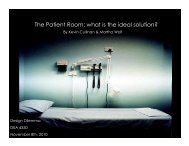The role of physical design and informal communication
The role of physical design and informal communication
The role of physical design and informal communication
You also want an ePaper? Increase the reach of your titles
YUMPU automatically turns print PDFs into web optimized ePapers that Google loves.
ABSTRACT<br />
Graduate nurses experience a tremendous amount <strong>of</strong> stress as they transition<br />
from a student to a practicing nurse. Much <strong>of</strong> this stress can be attributed to a feeling<br />
<strong>of</strong> not having learned enough to function independently. While various formal<br />
learning strategies, such as graduate nurse orientation programs, have been<br />
implemented to solve this problem, not much attention has been paid to the potential<br />
<strong>of</strong> <strong>informal</strong> opportunities for learning. This study examined how components <strong>of</strong> the<br />
nursing unit ecosystem, including culture, organizational factors, technology, <strong>and</strong><br />
particularly the <strong>physical</strong> layout, influenced <strong>communication</strong> <strong>and</strong> opportunities for<br />
<strong>informal</strong> learning, stress, <strong>and</strong> the gaining <strong>of</strong> nursing competencies during the formal<br />
orienting period.<br />
Five different data collection methods were used, including systematic<br />
observation <strong>of</strong> <strong>communication</strong> <strong>and</strong> interaction patterns, a survey <strong>of</strong> organizational<br />
climate <strong>and</strong> opportunities for <strong>informal</strong> learning, self-recorded blood pressure,<br />
competency ratings, <strong>and</strong> focused interviews. <strong>The</strong> <strong>physical</strong> environment, particularly<br />
backstage areas <strong>and</strong> clear sightlines within the nursing station, fostered opportunities<br />
for <strong>informal</strong> <strong>communication</strong> <strong>and</strong> on-the-job learning; as well as relationships among<br />
nurses that contributed to effective collaboration.<br />
A combination <strong>of</strong> factors was found to influence the GN learning experience<br />
including past experiences, unit culture, personal learning style, unit layout, <strong>and</strong><br />
interaction with staff. <strong>The</strong> gaining <strong>of</strong> competencies was not associated with a<br />
reduction in stress, suggesting that other factors, particularly staffing levels, had more<br />
<strong>of</strong> an impact on stress than nursing competencies per se. <strong>The</strong> extent to which other<br />
social, organizational, <strong>and</strong> personal factors interact with staffing levels to produce<br />
stress or mitigate its effects deserves further study.







